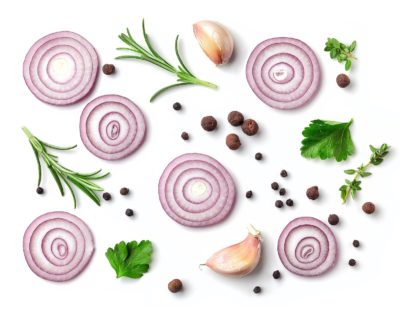Let’s talk about the best ways to stop bloating in its tracks. Here are my client tested tips for immediate and long term relief.
Bloating is an uncomfortable, hard, stretched out tummy and is a sign that gas is trapped (not moving through smoothly) in your digestive system. Clients often describe it like having a beach ball trapped in their gut. This can happen with too much gas production, or not enough steady movement of the digestive system muscles (a rhythmic squeezing action called peristalsis).
What causes too much air?
Too much air or gas in the gut can happen two ways. One, is you’re taking in too much air while eating. This one is surprisingly common in fast eaters, those who are working, talking, or doing other things while eating. If you often finish first, quickly jam in lunch while you’re standing over a plate in the kitchen or at your desk while you’re putting out fires in your email, this might be you. Carbonated drinks, using a straw and chewing gum can also increase the amount of air you swallow.
The second way too much air or gas happens is “dysbiosis”. Dysbiosis is an imbalance of good and bad gut bacteria. Sometimes the bad guys will take otherwise healthy foods and produce LOTS of gas (some gas production is normal) and that stretching will cause discomfort.
What causes slow motility?
Motility is the speed and regularity that your gut moves at. Slowed motility can be caused by constipation (not enough fibre and fluids), not enough activity, and one of the more common is dysbiosis we mentioned above. Some of the “bad” guys are methane producing, and too much methane actually interacts with the cells lining the gut wall, telling them to slow down.
So now we know what causes it, what can we do to stop bloating?
Quick Fixes for occasional bloating
-
Movement: Go for a walk, do a yoga or pilates video online, or even sit and stretch at home. Moving the big muscle groups can stimulate better motility and help free trapped gas.
-
Peppermint or ginger tea: Peppermint can help soothe the irritated gut lining (skip if you have acid reflux) and ginger has a mild direct effect on increasing motility to help free that trapped gas. Make a cup with two tea bags steeped for 5 minutes. I really like the Traditional Medicinals digestive tea found at most of our local grocery stores for occasional digestive upset.
-
Abdominal massage: If gas is trapped, helping to break it into smaller bubbles and stimulate the gut tissues can be helpful. On bloaty days, spend 2-3 minutes a few times throughout the day with a medium pressure moving in a circular pattern (Start at the top, move down to your left, down, up to the right, back to the top).
Normal vs abnormal bloating
Occasional bloating is completely normal, some foods are naturally more fermentable and actually really wonderful for our “good” gut bacteria. If you have mild, occasional bloating don’t sweat it. We should have a small amount of expansion after each meal – both in the stomach right away, and a couple hours later in your lower gut as your good gut bacteria enjoy the meal.
Too much air coming in:
-
Slooooooow it down. If you struggle with this, put your fork down between bites, use chopsticks or another device to help your brain find a new speed.
-
Chew, chew, chew. We’re aiming for the consistency of applesauce.
-
Try cutting out your sparkling water, kombucha, soda or other carbonated drinks for a few days
-
Swap to a water bottle that doesn’t have a straw and see if it helps
-
Make sure you’re sitting down, away from the desk while you eat so you don’t power it in without thinking.
Slow Motility – not enough fibre or fluids
Cover your basics first. Are you getting enough fibre and fluids? If you’re not sure, check out this post for tips on how to get more.
-
Aim for 2.5-3 L of water per day (if you’re low to medium active)
-
Get 2-3 cups or big handfuls of non starchy veggies at each meal
-
Try 1-3 prunes daily if your poops aren’t soft, regular and easy to pass.
-
Try double strength ginger tea daily
Find any food triggers: Look for patterns (don’t micromanage the day to day)
-
Ravioli with alfredo sauce
-
Garden salad with Italian dressing, sliced red onions, tomatoes, and cubed apples on top.
How to use a food and symptom journal
So we need to look at the big picture and find patterns, foods that repeatedly cause symptoms when we eat them. We do this with a food and symptom journal! I encourage my clients to collect the information but review it no more than every few days or weekly so you’re not tempted to rip out every food you’re suspicious of. You can do this by:
-
Keeping a written diary of what you ate (don’t forget details like dressing, salad toppings, sandwich fillings, and drinks) and when you had symptoms of bloating or discomfort.
-
Using a note in your phone to do the same
-
An easy to use food and symptom tracker like Cara – its an app designed for people with digestive symptoms and is really easy to use. One of my favourites with clients!
-
Garlic and onions
-
Beans, lentils, and legumes
-
Dairy products (lactose) like milk, creamy sauces, ice cream (and if more severe yogurt and cheese)
-
Tree fruit like apples and pears
-
Wheat – bread, crackers, pasta, baked goods
-
Cruciferous veggies – cabbage, cauliflower, kale, brussel sprouts, cole slaw, sometimes broccoli
These are all high “FODMAP” foods, ones that are fermentable by the bacteria in your gut (good and bad) and given the right conditions might create too much gas.
Pro Tip:
I hope this was helpful for those of you struggling with occasional or chronic bloating. It is SO uncomfortable. If you’ve been struggling with digestive issues for a long time or feel like everything causes issues, I’d love to help you. Complex digestive issues are hard to solve on your own, an experienced Dietitian can strip down the overwhelm and get you on the path to feeling good.
Need some help getting your meals for the week balanced and prepared? If you’d like to receive our free Meal Planning Getting Started Guide AND get in on our weekly emails about all things nutrition so you can get clarity and confidence on what you’re eating, join us here!





